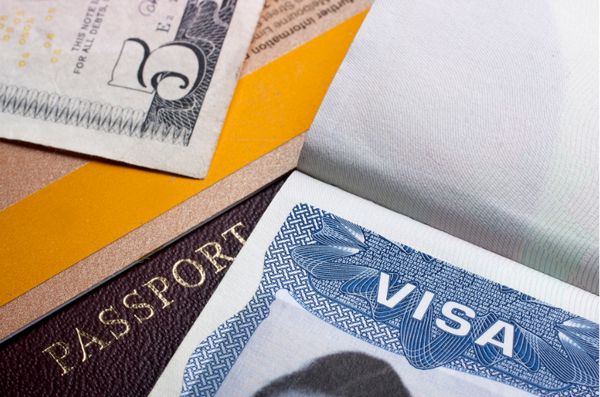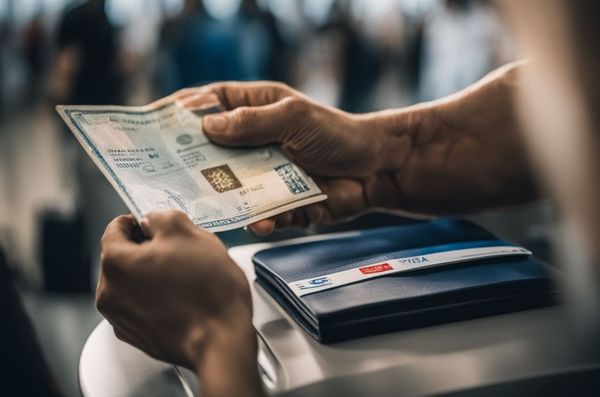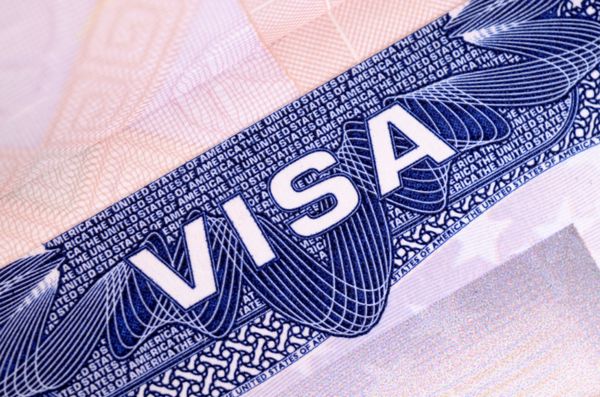Finding the right visa for traveling to the USA can feel overwhelming. Did you know there are two main types of US visas? This article will guide you through the types of immigration visas USA, making it easier to understand your options.
Keep reading for all you need to know!
Understanding U.S. Visas
To visit or move to the U.S., you need a visa. There are two main types: nonimmigrant for short stays, and immigrant for living there.
Nonimmigrant visas
Nonimmigrant visas let people stay in the US for a short time. People come for many reasons like work, study, or travel. Each reason has its own kind of visa. For example, students get an F-1 visa and workers might get an H-1B visa if they have special skills.
There’s even a B-1/B-2 visa for tourists and business visitors.
The right visa depends on why someone wants to visit the US. Getting one involves filling out forms and sometimes going to interviews. Next up, we’ll talk about immigrant visas – these are for folks planning to make the US their new home.
Immigrant visas
Immigrant visas are for people who plan to live in the US forever. These visas cover different types, like family-based immigration and work. For example, if you have family in the US, you might get a visa through them.
Or, if you have special job skills that are needed in the US, there could be a work visa for you.
To get an immigrant visa, you must follow many steps and meet certain rules. Each kind of visa has its own requirements. If you want to move to the US for good, it’s key to find out which type of immigrant visa fits your situation best.
This way, starting your new life in America can be smoother and faster.
Types of Immigrant Visas USA

In the U.S., there are many paths for people from other countries to come and stay. These visas help family members unite, workers find jobs, and others start a new life in America.
Family-Based Immigration
Family-Based Immigration helps people who want to live in the USA join their family members. If you have close relatives in the US, like a spouse, child, or parent, they might be able to help you get an immigrant visa.
This type is for those planning to move permanently. The US gives many visas every year for families to come together.
Next up is the Fiancé(e) Visa – another way people come to the US because of love and plans for marriage.
Fiancé(e) Visa
A Fiancé(e) Visa lets someone from another country come to the U.S. to get married. The person getting this visa must marry their U.S. citizen partner within 90 days of arriving. After the wedding, they can apply to live in the U.S. permanently.
This visa is a good choice for couples ready to start their lives together in America.
To get one, you need proof of your relationship and plans to marry soon. Both partners must be free to marry and have met in person at least once in the last two years, unless meeting face-to-face would cause extreme hardship or goes against cultural norms.
This process helps keep lovebirds together and starts them on their path toward making the U.S their new home.
Employment-Based Immigration
Employment-based immigration lets people move to the USA for work. There are different types of work visas in the US for this. Some are for people with special skills or jobs that need advanced degrees.
Others are for workers who have a job offer in the United States. This kind is great because it helps fill jobs where there aren’t enough American workers.
Each type has its own rules and steps to follow. The company in the US that wants to hire someone from another country often helps with the visa process. They show why they need a worker from outside the USA.
This way, people from all over can come and work in America, bringing their skills and helping businesses grow.
Returning Resident Visa
A Returning Resident Visa is for those who lived in the U.S. but had to stay abroad for reasons beyond their control. This visa lets them come back to live in the U.S. permanently.
To get this visa, you must show that you did not plan to leave the U.S. for so long and your long stay outside was not your choice.
You need proof like documents that show why you stayed away and that you kept ties with the U.S. during this time. This type of visa makes sure people can return to their home in the U.S., even after an unexpected long stay in another country.
Diversity Visas
Diversity Visas are a special chance for people from countries with low rates of immigration to the US. Every year, the US gives out 50,000 visas through a lottery. This program aims to mix up where immigrants come from.
To enter this lottery, you must be from an eligible country and meet simple education or work experience requirements.
Winning the lottery does not guarantee a visa right away. Winners still need to pass interviews and checks. Yet, for many around the world, Diversity Visas open doors to new opportunities in the US.
It’s like holding a golden ticket to start fresh and chase dreams in another land.
Adoption
Switching from the chance of winning a spot through Diversity Visas, we move to adoption. This is for those looking to bring a child from another country into their family forever.
The process includes getting an immigrant visa for the child. This type of visa falls under specific categories in US immigration law.
People looking to adopt need to follow strict rules. They must prove they can care for the child. The process checks everything carefully before allowing the child to come live in the USA permanently.
It’s a way for families to grow by welcoming children from around the world, showing how diverse and inclusive America can be.
Applying for a U.S. Visa

Getting a U.S. visa starts with knowing what kind you need. Then, it’s time to fill out forms and get ready for your interview.
Requirements for immigrant visas
Applying for a U.S. immigrant visa takes careful planning. Each type has specific rules to follow. Here’s what you need to know about the requirements:
- Complete the Right Form: You start by filling out DS-260, the Immigrant Visa Electronic Application. Make sure all your information is correct.
- Passport Validity: Your passport should be valid for at least six months after your planned entry into the U.S.
- Photograph Requirements: You’ll need two recent photos in a specific format, matching the guidelines given by the embassy.
- Civil Documents: Bring official documents like birth certificates, marriage certificates, and police clearances from your country.
- Financial Support Proof: Show that you won’t rely on U.S. government aid. This often means having a form I-864 filled out by your sponsor in the U.S.
- Medical Examination: A doctor approved by the embassy must check you’re in good health and vaccinated as needed.
- Interview Appointment: Attend an interview at the U.S. embassy or consulate in your home country when they tell you to come.
- Visa Fees: Pay all necessary fees before your interview unless told otherwise.
- Job Offer (if applicable): For work-based visas, have proof of your job offer in the U.S.
- Special Requirements for Certain Visas: Some visas might ask for extra stuff, like proof of relationship for family-based visas or investment evidence for investor visas.
Each step is crucial for moving forward with your application process. Make sure to check everything off this list!
Work visa options for foreign nationals
After exploring the requirements for immigrant visas, let’s shift our focus to work visa options for foreign nationals. Many people from around the world dream of working in the USA. To make this dream come true, you need the right kind of visa. Here are some options:
- H-1B Visa – This is for jobs that require a specific set of skills. Tech companies often use it to hire workers from other countries.
- H-2A and H-2B Visas – These are for temporary agricultural and non-agricultural jobs. If there’s a short-term need for workers, these visas help fill the gap.
- L-1 Visa – Great for employees of international companies who are moving to a U.S. branch. This includes managers and those with specialized knowledge.
- O-1 Visa – This is for people with extraordinary abilities in science, arts, education, business, or sports.
- E-3 Visa – Specifically designed for Australian nationals who wish to work in specialty occupations in the U.S.
- TN Visa – Thanks to NAFTA (North American Free Trade Agreement), citizens of Canada and Mexico can apply for this visa to work in certain professions in the US.
Each option serves a unique purpose and fits different job situations. From tech wizards to talented artists, there’s a path for talented individuals from across the globe to work in the USA. The key is finding which visa matches your situation best and meets all specified requirements and eligibility criteria outlined by US immigration policies.
Visa policies and entry to the USA
So, after talking about work visa options for foreign nationals, let’s move to visa policies and entry into the USA. Knowing these policies helps make your travel plans smoother.
- The type of visa you need is based on your travel purpose. For example, if you’re visiting for fun, a B-2 tourism visa fits best.
- The application process starts online. You fill out a form and schedule an interview at the U.S. Embassy or Consulate in your country.
- Your passport must be valid for at least six months beyond your stay in the U.S. This rule makes sure you don’t run into trouble while traveling.
- Always check if there’s a Visa Waiver Program for your country. If yes, you might not need a visa for short visits.
- Bring all necessary documents to your visa interview—like proof of ties to your home country and evidence of financial support during your stay in the U.S.
- Each visa category has its own fee. Make sure you know how much yours costs and pay it before your interview.
- After applying, wait times for approval vary by location and season; so, plan ahead.
- Some visas require a sponsor in the U.S., like work or family visas; gather all needed info from them early on.
- Health – related issues could affect your entry into the U.S.; certain conditions might require proof of treatment or vaccination.
- Lastly, know that entering the U.S does not guarantee entrance; final approval is up to the border officer who reviews your case upon arrival.
Understanding these steps helps ensure you meet all requirements for visiting or moving to the USA without hiccups on arrival day!
Conclusion
Understanding U.S. visas opens doors for many. Whether aiming to live here or just visit, there’s a visa that fits every need. From work to family, the choices are diverse. Applying takes some effort, but knowing your options makes it easier.
Ready for an American adventure? The right visa can help make it happen!
Frequently Asked Questions (FAQs)
What are the main types of immigration visas in the USA?
In the USA, there are several immigrant visa categories... like family-based, employment-based, and diversity lottery visas. Each one has its own path and rules for applying.
Can I work in the US with an immigrant visa?
Yes! Many US immigrant visa types allow you to live and work here. Different types of work visas in the US cater to various job roles... so, it's about finding the right match for your skills.
How do I know which US immigration visa category is right for me?
It depends on your situation... If you have family here, a family-based visa might be best. For jobs, look into employment-based options. It’s all about what fits your needs.
Is getting an immigrant visa to the USA hard?
Well, it can be challenging due to paperwork and requirements... But knowing your specific immigrant visa category helps streamline things a bit—each category has its process.

